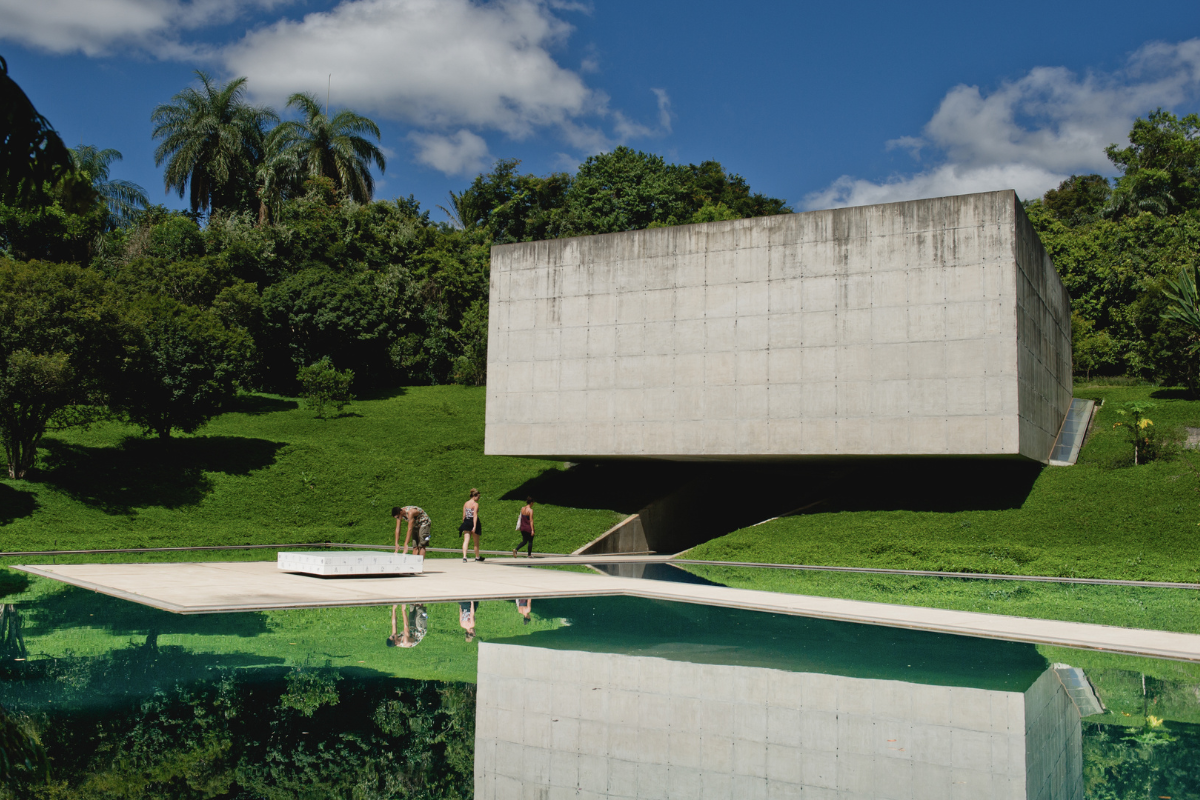A small mining town in rural Brazil might seem an unlikely place for Latin America’s largest open-air museum. Yet, that is where art buffs and curious tourists will find the Instituto Inhotim, a contemporary-art-gallery-cum-botanical-garden nestled among mining-scarred mountains some 60 kilometers outside of Belo Horizonte, the state capital of Minas Gerais.
Everything about Inhotim feels extravagant. Three days can seem insufficient to take in everything the place has to offer. The art is set within a verdant 140-hectare park, where over 4,300 species of plants from all over the world grow among the local Cerrado and Atlantic Forest biomes. Nearly 600 pieces of contemporary art are on display, some inside the 24 pavilions — many of which are works of art in themselves — others outside, in a carefully thought-out symbiosis with the surrounding environment.
“The relationship between art and nature is at the heart of the creation of Inhotim,” say the curators of one of the museum’s newest exhibitions, Ensaios Sobre Paisagem (Essays on Landscape), a collection of works by four young Brazilian artists.
It is this symbiosis that makes Inhotim magical. Pavilions with mirrored walls cast back the luxuriant vegetation surrounding it. Carefully maintained lakes reflect trees, works of art, and architecturally stunning pavilions. Gallery windows frame palm trees outside as if they were a painting. Giant tree trunks intricately carved into benches, no two alike, invite visitors to take a rest under the canopy.
But not everything about the surrounding environment is paradisiacal.
“We are in a state which has the name of a company, which exported many [commodities] all over the world,” reminded the Minas Gerais-born artist Paulo Nazareth during the recent opening of his first solo exhibition at Inhotim. Literally meaning ‘general mines’, Minas Gerais’ name carries the weight of its history of exploitation of natural resources, which was long dependent on slave labor.
Inhotim does not escape from this reality. A palm-lined road leading up to the park entrance gives visitors a taste of the botanical wonders that lie ahead — but the red dust that cakes the leaves is a very visible reminder of the iron ore extraction that drives the local economy in the town of Brumadinho.
Some of the gallery’s most famous artworks — like Doug Aitken’s Sonic Pavilion, which allows visitors to listen to the sounds of the earth, or Olafur Eliasson’s Viewing Machine, a giant telescope affording a view of the surrounding mountains — engage with the nearby mining industry. Newer exhibits especially, like Mr. Nazareth’s Esconjuro (Exorcise), denounce the damaging exploitation of natural resources. But they almost certainly wouldn’t be there without it.

‘A sweet fruit with bitter roots’
Indeed, Inhotim is the brainchild of a mining magnate who made a fortune selling pig iron to China. Bernardo Paz acquired a sprawling farm outside Brumadinho in the 1980s, got the renowned landscape architect Roberto Burle Marx to design the gardens, and started housing his growing collection of contemporary art there.
In 2006, Instituto Inhotim opened its doors to the public and very quickly made a name for itself on the international contemporary art circuit, for its installations ambitious in both scope and scale, its showcasing of Brazilian artists like Hélio Oiticica and Lygia Pape alongside big international names, and its work with artists onsite for the creation of commissioned pieces.
Mr. Paz had a vision. He wanted to create a Disneyland, “but serious”, he said in a 2011 interview with O Globo, in which he outlined plans for countless new pavilions and 10 hotels (to this day, there is no accommodation onsite, although a first boutique hotel is due to open in December). He described his gallery as “the greatest social project anyone in the world has ever done” and believed in the transformative power of Inhotim’s beauty — both natural and artistic.
Interviews that Mr. Paz gave over the years painted a picture of an ultra-wealthy man who despised the rich and their flashiness. He believed children and the poor could appreciate art better than the educated elite.
In this spirit, Inhotim has always let Brumadinho residents in for free (as well as being an important source of local jobs) and welcomed school groups. A lot of the art is interactive — such as swimming pools in which visitors can swim and rooms filled with balloons or hammocks — and delights children.
But the image of the shy, quixotic billionaire with a utopian project was shattered in 2017 when Mr. Paz was sentenced to nine years in prison for money laundering. He was accused of having used an account intended for Inhotim donations to move USD 98.5 million between 2007 and 2008 to meet obligations in his portfolio of mining companies. He was separately found guilty of tax evasion.
The following year, a Bloomberg Businessweek exposé entitled ‘The Financial Crimes That Fueled Brazil’s Inhotim Museum’ outlined the financial and legal issues that had dogged Inhotim from the start and alleged that one of Mr. Paz’s mining companies had committed environmental crimes and used child labor (the company in question, Replasa, denied the allegations).
In a 2018 interview with The Art Newspaper, the Brazilian artist Delson Uchôa described Inhotim as a “sweet fruit with bitter roots”.
A non-profit private institution largely funded by Mr. Paz, Inhotim was struggling financially amid this reputational imbroglio when Brumadinho suffered the deadliest mining accident in Brazilian history: in January 2019, the Córrego do Feijão tailings dam burst, unleashing 12 million cubic metres of toxic waste which flattened villages and killed 272 people. Inhotim was spared material damage, but took a further financial hit as visitor numbers plunged.
A new chapter
Five years and a Covid pandemic later, the gallery appears to be on firmer footing. Mr. Paz’s money-laundering conviction was quashed in 2020, following which he said he planned to concentrate on his art. The septuagenarian nonetheless detached himself from the institute, having previously stepped down as executive director; two years ago, he donated the 140-hectare park and 330 works from his collection to Inhotim.
Today, he remains involved as president of the advisory board (formed in 2022), but some visitors are unaware that they are wandering through what was once one man’s private garden and art collection.
The gallery has also embraced a growing movement to decolonize art, making a conscious effort to work with traditionally under-represented artists. A temporary exhibition inaugurated in 2022 hosts the Museu de Arte Negra (Black Art Museum), giving life to a longstanding dream of the late artist and civil rights activist Abdias do Nascimento. The star of this year’s new season of exhibitions is O Barco / The Boat, an installation by Portuguese multi-artist Grada Kilomba that recreates the bowels of a slave ship and questions the erasure of the history of transatlantic slavery.
“This is a new moment, a new cycle for Inhotim,” said Paula Azevedo, the institute’s executive director, during a press conference inaugurating the new exhibitions.
The ideal of democratizing art persists. The entrance fee is a relatively modest BRL 50 (about USD 10) and visits are free on Wednesdays. Gallery staff — many of them young Brumadinhenses — are encouraged to also enjoy the art. Earlier this month, employees in monochrome t-shirts packed into the press presentation of the dance performance accompanying Ms. Kilomba’s installation. One young woman expressed how inspiring it was to see a black woman like her “go so far”.
At the same time, the contradictions that underpin Inhotim since its creation nearly 20 years ago have not gone away. One of its biggest backers is mining giant Vale, with whom the institute signed a BRL 400 million sponsorship deal last year — funding this year’s new exhibits and allowing Inhotim to let visitors in for free once a week. Vale is one of the companies responsible for the mining accident that devastated Brumadinho and for which justice is yet to be served.
Some might say this dichotomy is the price to pay for the existence of such a unique place.










 Search
Search






































